
Mimulus, Monkey flower: planting and care
Contents
Mimulus in a nutshell
- Mimulus is a beautiful perennial plant that favours damp areas of the garden
- Upright or mat-forming, it displays flowers in vibrant colours on dense green foliage
- Frost-tender or hardy depending on species, it is often grown in colder regions as an annual in open ground or in pots to be brought indoors for winter
- It’s a very thirsty, easy-to-grow plant provided it never lacks water
- An ideal plant to add wild elegance to cool, moist borders and pond edges
A word from our expert
Mimulus or mimule is a perennial plant known to be not very hardy, usually grown as an annual in gardens, although some species such as Mimulus aurantiacus or orange Mimulus and Mimulus luteus or yellow Mimulus tolerate open ground down to at least -10°C.
Meanwhile, Mimulus guttatus is one of Bach’s 38 flower remedies recommended for people who are shy to calm fears and anxieties.
All Mimulus are prized for their bright, sometimes multicoloured flowering that lasts from May until first frosts.
Accessible to all gardeners, very easy to grow, requiring only consistently moist soil, but also tolerating any good garden soil provided it does not become too dry in summer.
With little maintenance, Mimulus is perfect for adding colour to edges of water features, to all damp areas of the garden, cool borders and even pots placed in non-scorching sun.
Discover our Mimulus, these cheerful, colourful plants around a pond and in cool soils!
Description and botany
Botanical data
- Latin name Mimulus
- Family Scrophulariaceae
- Common name Mimulus, Monkey Flower
- Flowering May to October
- Height 0.20 to 1.50 m
- Exposure Sun, partial shade
- Soil type fresh to moist
- Hardiness variable depending on species
The mimulus or monkey flower is a herbaceous perennial plant of the family Scrophulariaceae, like snapdragon and Diascia, most often native to wet regions, riverbanks and lakes of Asia, America, Mexico, Australia and South Africa. The genus includes about 180 species, annual or perennial plants, sometimes shrubby, most of which are tender and therefore usually grown as annuals in our climates. However, some species such as Mimulus luteus, Mimulus ringens and Mimulus guttatus display some hardiness down to -10°C and sometimes -20°C. The latter is among the more widespread species along with Mimulus cupreus.
There are numerous cultivars and hybrids derived from Mimulus guttatus and Mimulus luteus, such as Mimulus x hybridus, offered in a wide range of colours and heights.
Depending on species and cultivars, mimulus adopts a variable habit; erect, semi-trailing, even trailing or very tapetum (Mimulus luteus). The smallest Mimulus varieties will not exceed 20 cm in height for the Mimulus cupreus, a dwarf species, whereas the tallest form bushy clumps from 0.70 up to 1.20 m in height and as wide for shrubby species such as Mimulus aurantiacus.
Although growth is fairly rapid, Mimulus is a short-lived perennial that benefits from regular propagation to maintain it in the garden. Except for hybrid varieties, it also thrives by self-seeding readily in heavy, moist, clay soils.
Mimulus forms a small shrub most often very tapetum with deciduous foliage, rarely evergreen in our climates, with the exception of Mimulus aurantiacus or orange mimulus.
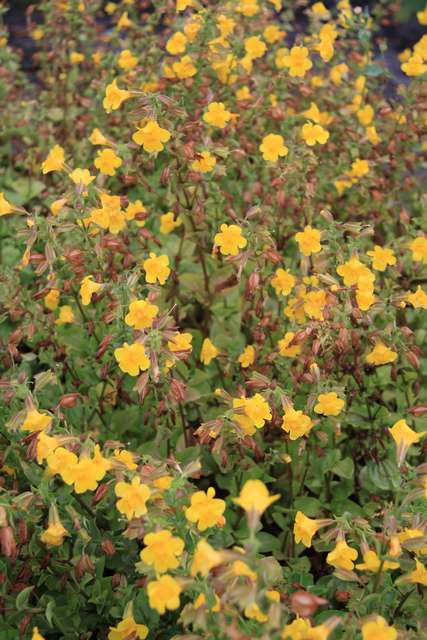
Mimulus guttatus in flower
Stems often pilous bear opposite leaves, oblong, rounded or linear, entire, slightly or strongly dentate, sessile on upper parts and petiolate lower down the stems. Leaves are sometimes covered with a fine velvet or even sticky. This dense, vigorous growth, from light green to grey-green, sometimes initially bronze then green, is overtaken by the long and very generous flowering of Mimulus.
Flowers with intense, varied colours appear in the axil of the leaves. They open from June to September without interruption, standing out against the foliage. Stems, erect, semi-erect or prostrate, end in spikes of 3 to 8 trumpet- or funnel-shaped flowers. Enclosed in hairy calyces, they consist of 5 fused rounded petals; two upper petals turned back above three lower lobes of which the central lobe is larger. These bilabiate corollas with a gaping, pilous throat resemble a smiling, tongue-sticking face or the mocking face of a monkey. A morphology that earned mimulus the English name ‘Monkey Flower’ or “the monkey-flower”.
Flower size varies by variety and hybrid. They measure from 2 to over 10 cm across for the largest, such as Mimulus x Hybridus ‘Maximus Mixed’, which bears giant flowers on average four times larger than most mimulus flowers.
Mimulus flowers come in an infinite range of vivid monochrome colours from bright yellow, coppery orange (Mimulus cupreus), pink, scarlet red (Mimulus cardinalis) to pastels ranging from white, pale blue-violet (Mimulus ringens or blue Mimulus) to pale yellow (Mimulus ‘Highland Yellow’).
There are also bicolour varieties, fully marbled or striped, or those with a throat subtly flecked in a contrasting colour (spotted Mimulus or Mimulus guttatus, Mimulus x hybridus ‘Monkey Magic’ F1 Hybrid’, ‘Calypso F1’).
While most Mimulus flowers are unscented, some species like Mimulus moschatus emit a distinctive musky odour, hence the other name “musk flower” sometimes applied to the plant.
This endless flowering is melliferous, attracting many pollinating insects.
Even if some hardy mimuli (down to -15 to -20 °C) can resist cold, most hybrids are tender perennial plants that fear frost (maximum -5°C) and are therefore often grown as annuals in our climates. To keep plants from one year to the next, it is preferable to cultivate them in pots that can be overwintered in a frost-free room or greenhouse and brought out in the growing season.
The mimulus is grown in non-scorching sun or light partial shade in a humus-bearing soil that is fresh to permanently moist.
It suits naturalistic or exotic-style gardens, around ponds, in garden wet zones, borders and rockeries that retain summer moisture, and even in cool containers.
By virtue of its medicinal properties, Mimulus guttatus is one of the 38 Bach flowers used in alcoholic maceration to soothe fears and help control emotions. As a poultice on minor burns, its leaves soothe the fire. Entirely edible, mimulus absorbs sodium chloride from the soil, retaining a salty taste that Native Americans used as a salt substitute.
Read also
10 aquatic plants, submerged or floatingMain species and varieties
Mimulus is perennial in its natural habitat but has a reputation for being not very hardy in our climates (-5 °C for the more tender such as M.cupreus, -20 °C for the hardiest species such as Mimulus guttatus, Mimulus luteus, Mimulus ringens and Mimulus cardinalis). In our gardens it is therefore grown either as an annual or as a perennial.
All appreciate soil that remains cool to even moist, some mimulus such as Mimulus luteus even tolerating shallow immersion. They therefore lend themselves to multiple uses, on the banks of a pond as well as in beds, rockeries or in pots that stay cool.
Among the 180 species in the genus, Mimulus guttatus or maculate mimulus and the Mimulus cupreus, a creeping frost-tender species grown as an annual, are the most widespread. They are available in numerous cultivars and hybrids with bright colours, plain or variegated, such as Mimulus x hybridus which offers a wide choice of colours.
Heights vary from the dwarf mimulus (20 cm), well suited to being grown in pots, beds and borders, to shrubby mimulus such as Mimulus aurantiacus or orange mimulus which can reach 1.20 m in height.
Most popular
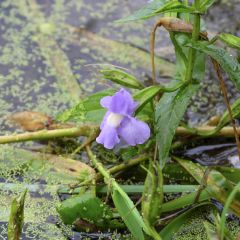
Mimulus ringens
- Flowering time July to October
- Height at maturity 70 cm
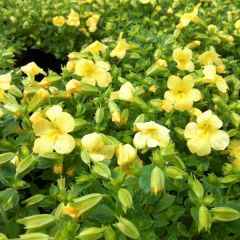
Mimulus Highland Yellow
- Flowering time July to October
- Height at maturity 20 cm
Our favourites
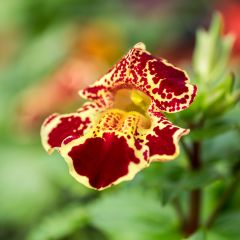
Mimulus luteus
- Flowering time July to October
- Height at maturity 80 cm

Mimulus hybridus Maximus Mixed
- Flowering time July to October
- Height at maturity 60 cm
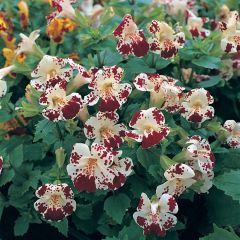
Mimulus Monkey Magic F1 Seeds - Monkey flower
- Flowering time July to October
- Height at maturity 25 cm
Discover other Mimulus
View all →Available in 1 sizes
Available in 1 sizes
Available in 1 sizes
Available in 1 sizes
Available in 1 sizes
Available in 1 sizes
Available in 1 sizes
Available in 1 sizes
Available in 1 sizes
Planting
Where to plant mimulus?
Hardiness varies among mimulus: some are frost-tender to -5°C, others are hardy to -20°C, for example Mimulus ringens! The most tender mimulus will be grown as annual under our climates in open ground or in a pot to be brought indoors to overwinter.
It needs a sunny but non-scorching exposure to flower abundantly. In south of France, it prefers partial shade.
Very easy to grow, it must never lack water! A perennial of wet medium, mimulus particularly enjoys cool, marshy areas. Offer a fresh to very wet, light, well-drained and humus-bearing soil. It adapts to many situations, managing to grow where few plants thrive. Undemanding, it tolerates any good garden soil not too dry in summer, without stagnant moisture though. It will have more difficulty acclimatising in Mediterranean climate, too dry in summer.
That said, growing conditions can vary significantly from one mimulus to another. While Mimulus luteus tolerates shallow immersion up to 10 cm deep, Mimulus cardinalis tolerates flooded soils, Mimulus aurantiacus is an exception, dreading excess water and proving more drought-tolerant while preferring a light, well-draining soil. Mimulus cupreus is a dwarf species sometimes used in aquaria.
Mimulus will thrive almost anywhere in wet areas of a natural garden or exotic garden, provided site remains cool. Its exotic flowering will be striking in the foreground of cool herbaceous borders, in rockeries and even in a pot. Creeping species will form excellent groundcover to scallop pond edges or creep along damp banks where they find all moisture they need.
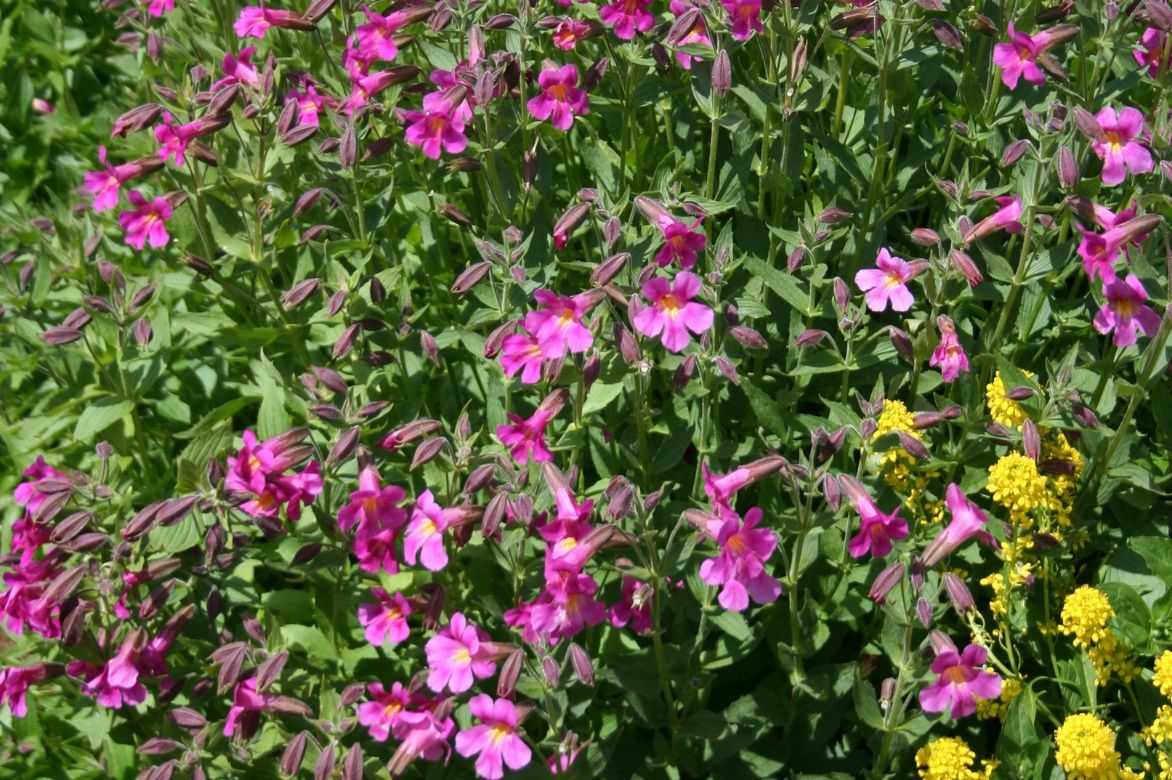
Mimulus lewisii
When to plant?
Plant Mimulus in bucket from March to May when risks of severe frosts have passed, or from September to November after high summer heat.
How to plant?
In open ground
Plant 3 to 5 mimulus per m² spaced 20 to 50 cm apart. If soil is too dry, choose a much less thirsty plant.
- Dig a hole 2 to 3 times wider than the bucket
- In very poor soil, add some well-rotted compost or composted manure to bottom of hole
- Place rootball and backfill
- Firm down then water thoroughly
- Keep soil around base cool with organic mulch
In pot
Growing mimulus in pots is perfectly possible provided rootballs are kept moist in summer and winter.
- Spread a good layer of drainage (gravel or clay pebbles) at bottom of pot
- Plant in a mix of garden soil, turf, sand and compost kept consistently moist
- Mulch and water very regularly, never allowing substrate to dry out
- Feed regularly with an organic fertiliser during flowering period
When and how to sow Mimulus?
Sow Mimulus seeds in seed trays in spring from March to May for transplanting outdoors once all risk of frost has passed.
- Sow in trays on surface of a good seed compost
- Do not cover seeds
- Keep warm and in light at 20–30°C
- Keep moist until germination (10 to 21 days)
- When young shoots have 5 leaves, pot on into buckets
- Plant out in ground or into pots after risk of frost has passed
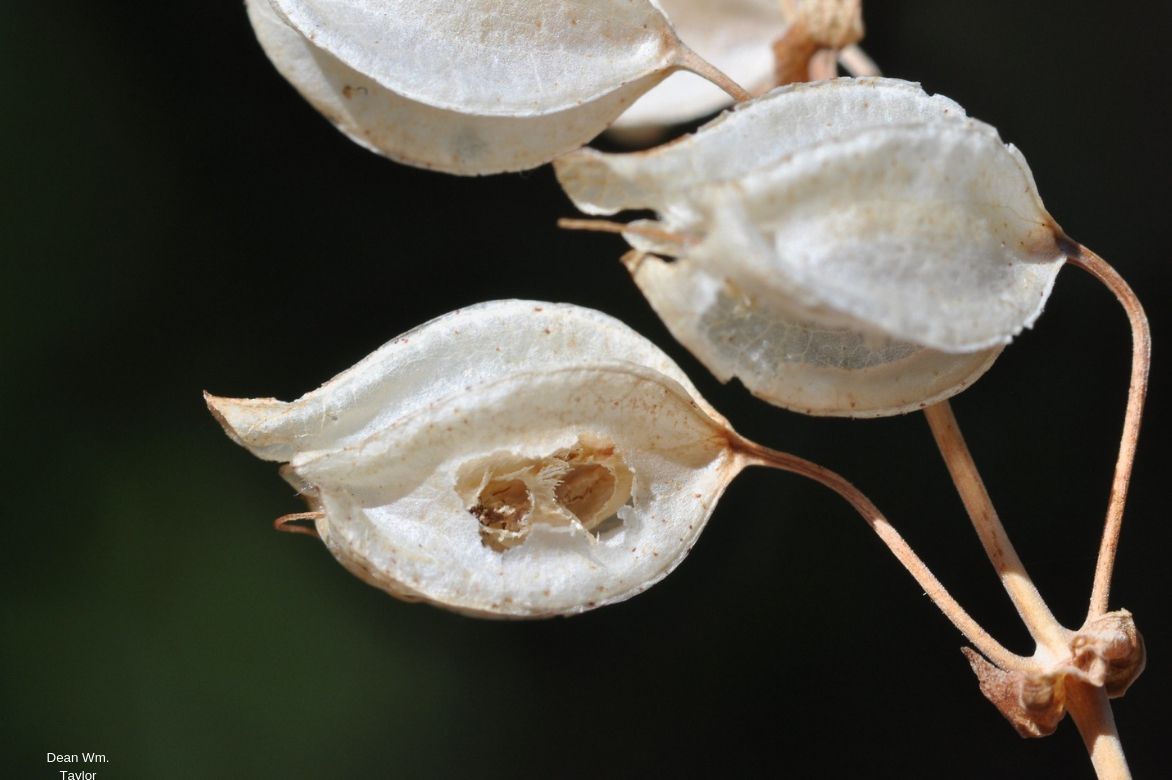
Mimulus seed capsules
Follow our tips to succeed with your seed sowing!
Caring for and treating monkey flowers
Mimulus requires little attention provided soil remains sufficiently moist.
To flower abundantly, in pots as well as in open ground, it needs a lot of water, especially during prolonged drought: water very regularly.
Mulch in summer to retain moisture at base and reduce watering.
In periods of severe heat and lack of water, flowering may stop: cut back the clump to one-third or half its height to encourage it to flower again.
Fertilise every year in March with compost and apply a flowering plant fertiliser monthly to potted mimulus.
Pinch young shoots at start of growth to encourage plant to ramify.
Regularly remove faded flowers to prolong flowering.
In regions with mild winters, after flowering prune off dried parts then spread a mulch of dead leaves at base to protect stumps from frost. At very start of spring, clean clumps.
In cold regions, mimulus succumb to frost: lift clumps before winter.
If you nevertheless wish to keep your mimulus for several summers, store pots indoors over winter, keep them frost-free to bring out again in following spring. Cut back the clump, mulch and continue watering even in winter.
Potential diseases and pests
Snails and slugs love young foliage of mimulus at the start of growth: we provide tips to control gastropods!
Not prone to disease, mimulus is really only susceptible to powdery mildew, especially during prolonged drought. As a preventative measure to stop this harmless fungus leaving a white coating on foliage: spray Bordeaux mixture or nettle and horsetail manure. Find how to prevent and treat powdery mildew on our blog: how to prevent and treat powdery mildew.
Propagation: cuttings and division
When soil suits it, Mimulus readily self-seeds. However, it is a short-lived, frost-tender perennial that benefits from being maintained as a perennial, although some species survive milder winters. Mimulus is propagated by sowing, by stem cutting or by clump division in spring, March–April. Sowing is easy to do (follow our tips above!) with our Mimulus seeds.
How to take stem cuttings of Mimulus?
Cuttings are easy to root in water.
- In spring, take non-flowering stem tips 10 cm long
- Remove lower leaves
- Place in jars filled with water until cuttings form roots
- Pot cuttings into buckets
- In autumn, plant them in the garden
Division
- Using a spade, gently separate offsets from well-established clumps that have sufficient roots and some leaves
- Replant immediately in the garden or in pots
- Water to encourage root re-establishment
Companion planting for Mimulus
Mimulus invests naturalistic gardens to brighten the edges of water features and cool, damp areas. It is unrivalled at contributing to natural atmospheres.
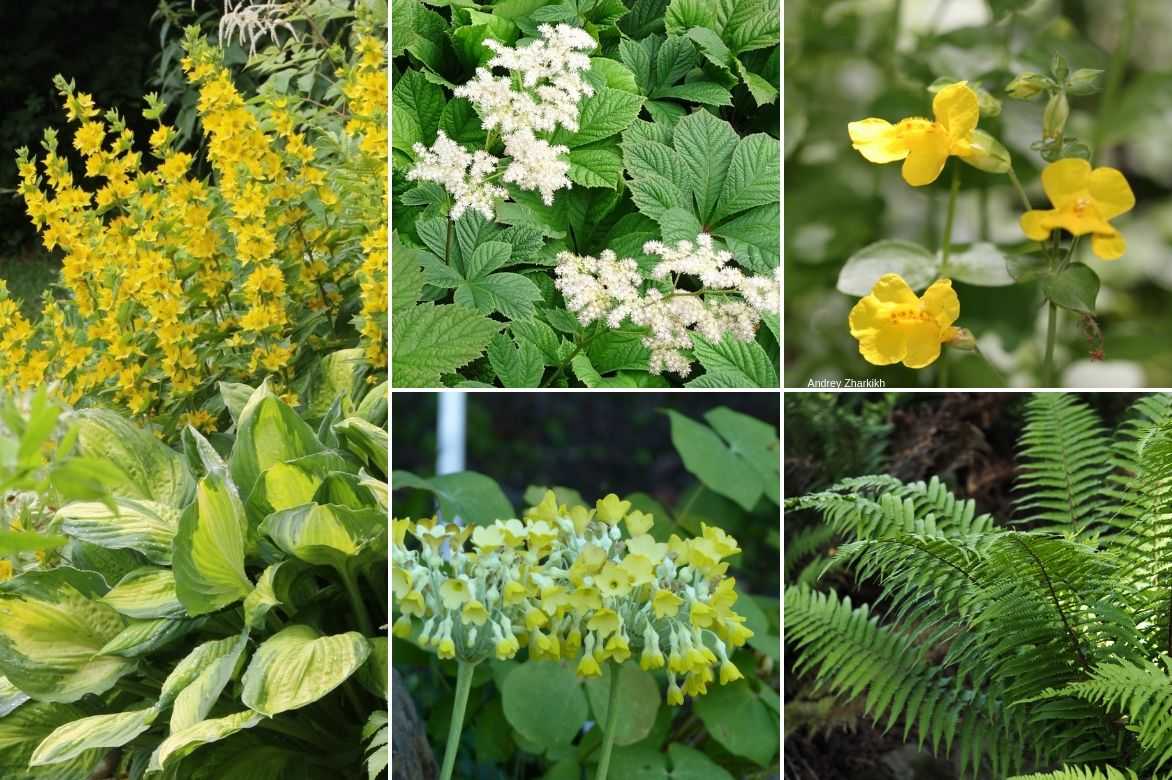
An idea for damp shade planting: Lysimachia punctata, Hosta, Rodgersia aesculifolia ‘Irish Bronze’, Mimulus (‘Highland Yellow’ for example), Primula florindae and Dryopteris wallichiana
With its bushy or creeping habit, it offers many uses and combinations.
At water’s edge, it will be companion to other perennials of damp banks, also preferring fresh soils such as Japanese iris, spiralled rushes, knotweeds or marsh euphorbias, alchemillas, artemisias, variegated calamus, golden lamiums or even mint in abundant refreshing green foliage.
In a humid, misty and elegant setting, plant it at the foot of astilbes, Goat’s-beard, and filipendulas, which will provide beneficial shade without concealing it.
At edge of a cool, romantic-inspired border, pair pale-yellow or blue-flowering mimulus with oblique stork’s-bill, Japanese primroses, purple loosestrife and Japanese anemones.
The colourful, mottled trumpets of hybrid mimulus such as ‘Monkey Magic’ F1 Hybrid or ‘Calypso F1’ will even find a place in an exotic garden (provided the plant never lacks water), alongside luxuriant perennials with broad foliage such as cannas, rodgersias, Colocasia ‘Madeira’, gunneras and hostas.
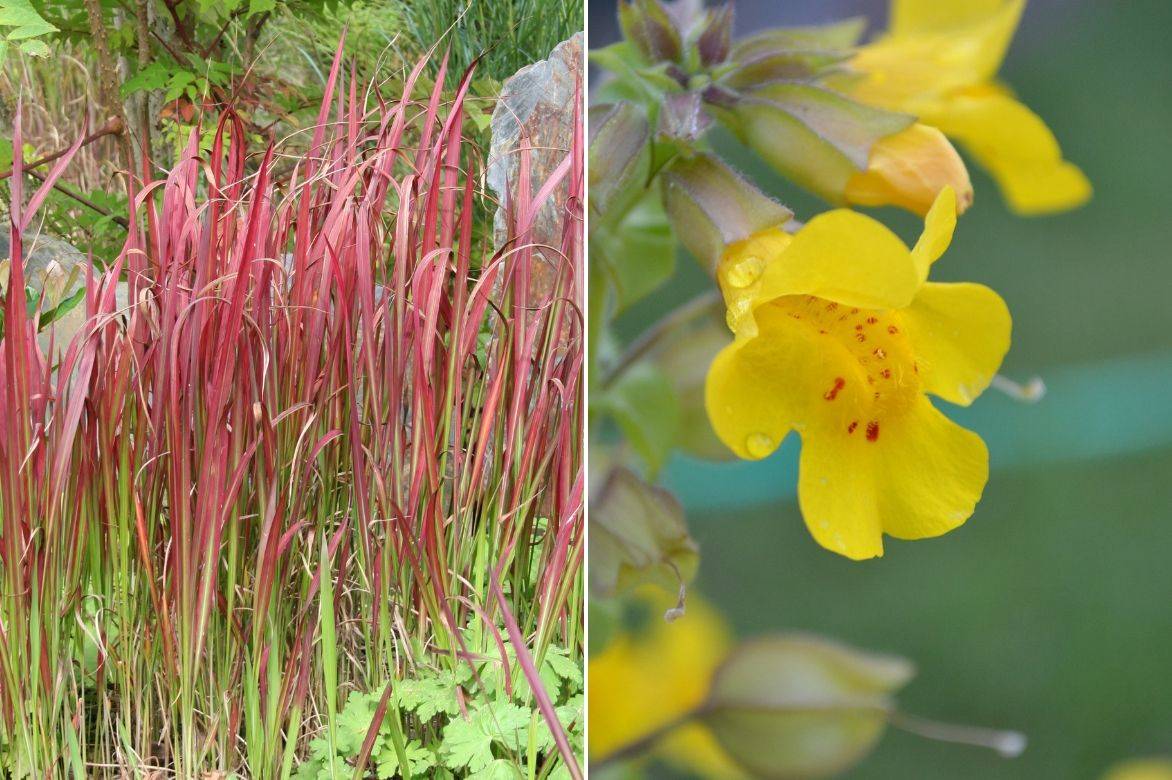
Another planting idea: Imperata cylindrica ‘Red Baron’ and Mimulus (M. tilingii for example)
Warm-coloured flowers of spotted Mimulus (Mimulus guttatus), scarlet Mimulus and Mimulus luteus will resonate with crocosmias and daylilies.
Pastel flowering of Mimulus ringens or “blue Mimulus” will offer a lovely contrast with acidic-yellow flowers of marsh euphorbias, ligularias, Lysimachias or harmonise with pale-violet tones of Siberian or Japanese irises.
Mimulus will form colourful groundcover in a grass planting surrounded by carex, Molinia or miscanthus.
Useful resources
- To showcase a pond or cool area of the garden, we offer a selection of perennial plants for fresh to moist soils
- Subscribe!
- Contents
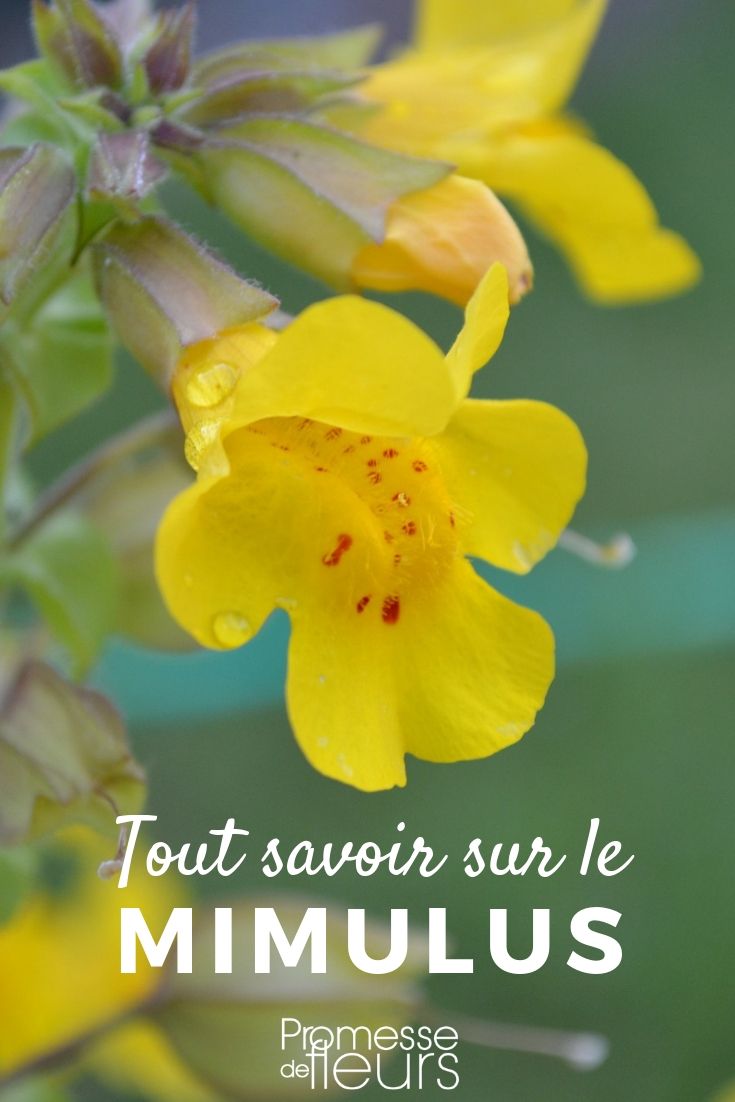



































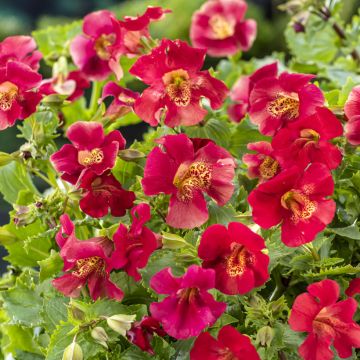
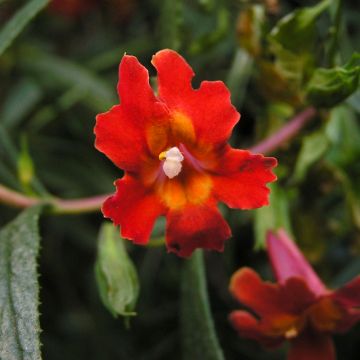

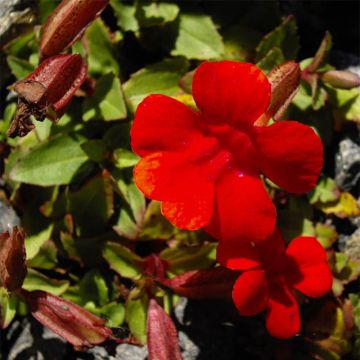
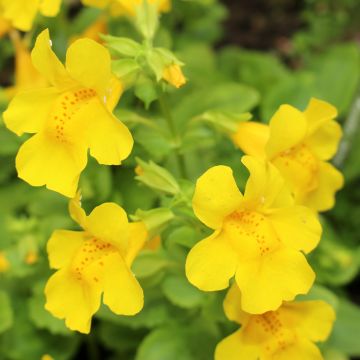


Comments